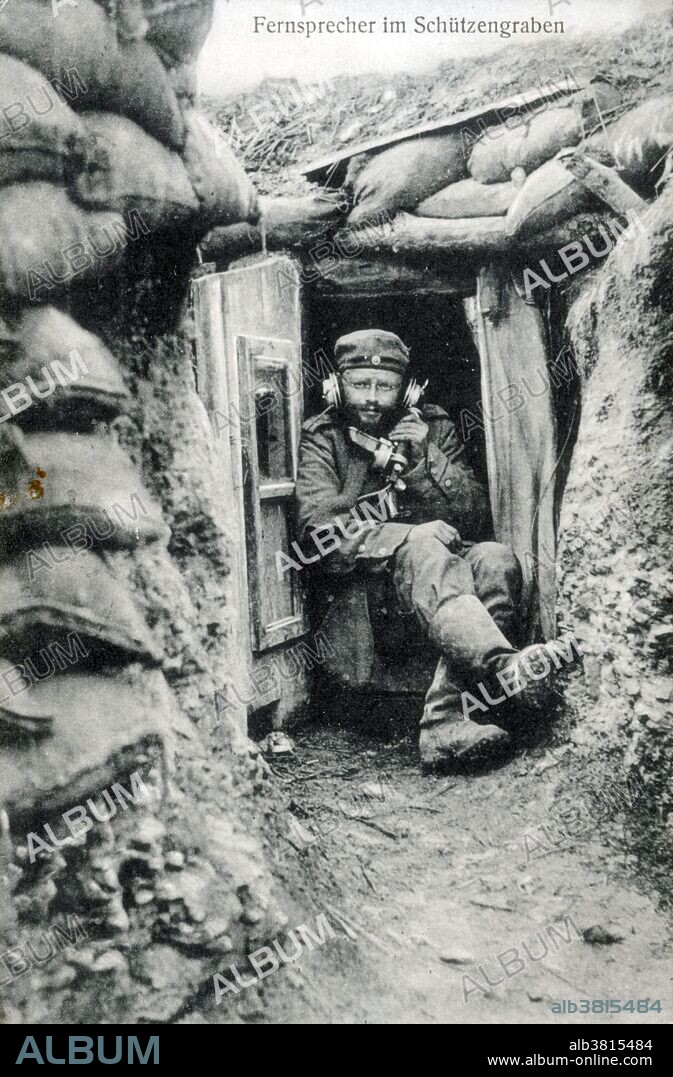alb3815484
WWI, German Army Field Telephone

|
Add to another lightbox |
|
Add to another lightbox |



Title:
WWI, German Army Field Telephone
Caption:
Telephones were used extensively in WWI because radio sets were large, heavy, expensive, in short supply, affected by weather, and could only be used for telegraph codes instead of voice communication. As the distances of guns increased, the telephone was particularly valuable to artillery forces, but the wires laying on the ground where they could be cut ot destroyed were a weakness. On the Western Front, the telephone allowed armies spread over great distances to coordinate unit activity. Carrier pigeons and motorcycle couriers were also used, but the telephone was the fastest. Trench warfare is a form of land warfare using occupied fighting lines consisting largely of trenches, in which troops are significantly protected from the enemy's small arms fire and are substantially sheltered from artillery. The most prominent case of trench warfare is the Western Front in WWI. Both sides constructed elaborate trench and dugout systems opposing each other along a front, protected from assault by barbed wire. The area between opposing trench lines (no man's land) was fully exposed to artillery fire from both sides. Attacks, even if successful, often sustained severe casualties. The common infantry soldier had only a few weapons to use in the trenches: the rifle, bayonet, and hand grenade. No date, location or photographer information given on postcard.
Credit:
Album / Science Source
Releases:
Model: No - Property: No
Rights questions?
Rights questions?
Image size:
2959 x 4500 px | 38.1 MB
Print size:
25.1 x 38.1 cm | 9.9 x 15.0 in (300 dpi)
Keywords:
1ST WORLD WAR • 20 XX TWENTIETH CENTURY • 20TH CENTURY • 20TH • ARMED FORCES • ARMIES ARMY • ARMIES • ARMY • BATTLE • BATTLEFIELD • BW • CELEBRITY • COMBAT • COMMUNICATIONS • DUGOUT • EVENT • FAMOUS • FERNSPRECHER IM SCHUTZENGRABEN • FIELD PHONE • FIRST WORLD WAR • FOOT SOLDIER • FOOT-SOLDIER • FRITZ • GERMAN • GERMANS • GLOBAL WAR • GREAT WAR • HISTORIC • HISTORICAL • HISTORY • HUNDRED YEARS WAR • IMPORTANT • INFANTRY • INFANTRYMAN • JERRIES • JERRY • MALE • MAN • MEN • MILITARY • NOTABLE • PHONE • PHOTO • PHOTOGRAPH • POST CARD • POSTCARD • SCHüTZENGRABENS • SOLDIER • SPEAKER PHONE IN PROTECTION DIG • TELEPHONE • TRENCH PHONE • TRENCH • TWENTIETH CENTURY • WAR • WARFARE • WELL-KNOWN • WESTERN FRONT • WORLD WAR I (1914-18) • WORLD WAR I • WW1 • WWI
 Pinterest
Pinterest Twitter
Twitter Facebook
Facebook Copy link
Copy link Email
Email

